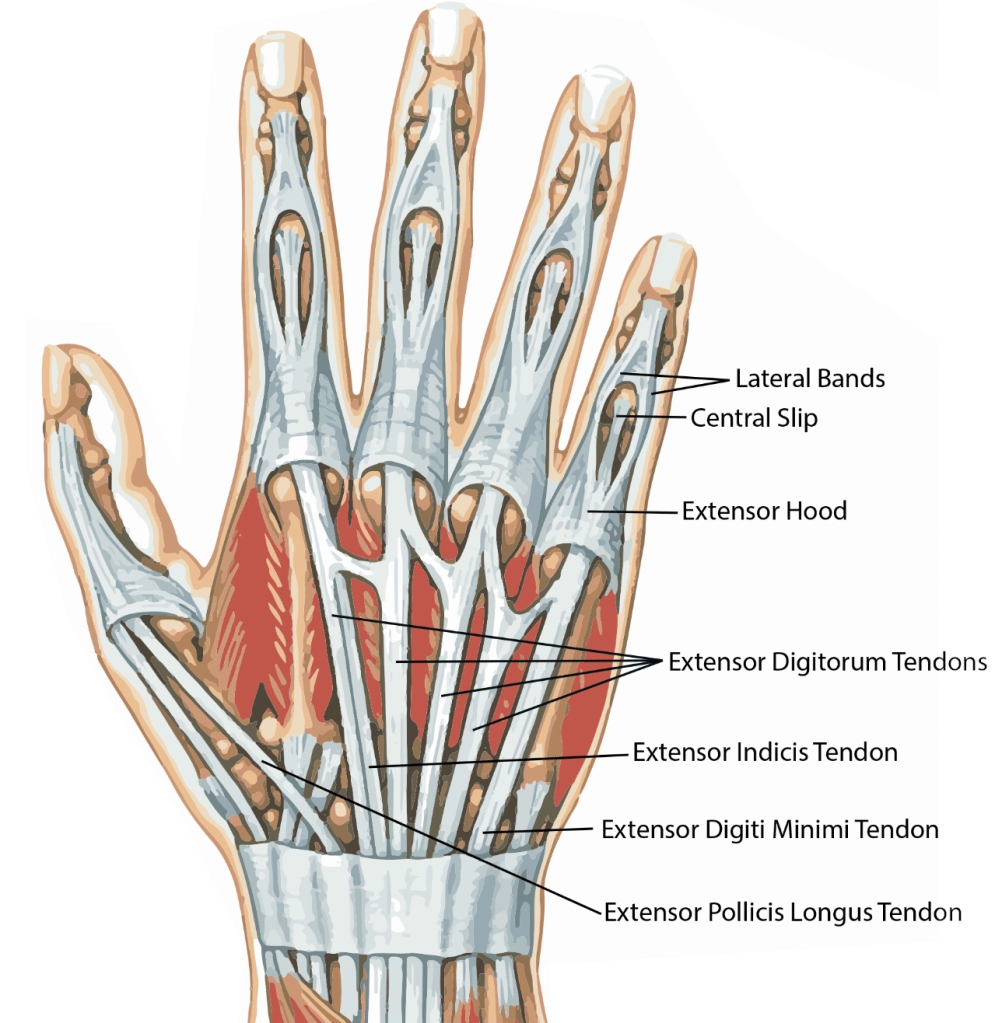What are the Extensor Tendons?
The extensor tendons of the hand are cord like structures that allow you to straighten your fingers or thumb (digits). They are continuations of the muscles from the back of the forearm. The tendons lie on the back of the hand and can often be seen when you gradually make a closed fist.
How are the extensor tendons injured?
There are 2 types of extensor tendon injury:
OPEN: Since the tendons lie close to the skin, they are prone to injury from cuts over the back of the hand, or from punching something sharp, such as a tooth!
CLOSED: These tendons can also be damaged without having sustained a wound. This is less common, but may happen following a wrist fracture, where the sharp edge of the bone erodes the tendon, or after punching something hard. It can also happen when the tendons are weakened by disease, such as arthritis.
What are the signs?
– Inability to straighten the finger
– Reduced power when straightening the finger
– Drooping of the finger or thumb compared to the other fingers
How is the diagnosis made?
The diagnosis is made on clinical examination. Often an X-ray is performed to ensure that is no glass in the wound or to assess any damage to underlying bone or joint.
What is the natural history?
When a tendon is divided, the muscle usually contracts and pulls the cut end of the tendon away from the other end, making direct healing impossible. Left untreated, therefore, tendons that have been cut completely are unlikely to heal by themselves and require surgical repair. If left untreated, however, a permanent droop of the finger can usually be expected. If the injury is in the finger, the resultant deformity can be severe, and interfere with normal function.
In the index finger and little finger, there are 2 extensor tendons, so unless both are divided, normal extension may be present with a complete tendon laceration. Another fairly common scenario is where the tendon is divided over the back of the hand, but interconnections between the tendons mean that the finger can still extend via the pull of the tendon next-door.
The presence of a wound over the tendon injury, particularly when the injury has been caused by a punch, can produce infection, and this infection carries a high risk of harm to the finger or hand.
In certain closed injuries such as those injuries at the end joint of the digit, or partially cut tendons these can often be treated with a splint, reducing the need for surgery.
What is the treatment?
Surgery: Surgery is recommended for the majority of extensor tendon lacerations. This involves either a local, regional or general anaesthesia. Generally, the wound is extended by the surgeon in order to fully expose the injured tendon. The wound is then carefully washed to remove any dirt or germs. The tendon is repaired and a splint or plaster cast is applied. Where the wound has been caused by a tooth, as in a punch injury, it is not considered safe to repair the tendon, and the wound is left open to heal with scar tissue, and any tendon surgery carried out a few months later.
Hand therapy: Hand therapy aims to balance protection of the tendon with splints with gradual loading or movement of the tendon with exercises. Splints are often used for closed (no wound) injuries. Splints may be used for as little as 2-3 weeks or in some instances up to 3 months. The hand therapy programme is individualised.
What are the complications of treatment?
Although the aim of repairing a cut tendon is to restore your function, patients may not recover full strength or movement back despite good surgical repair and hand therapy. There are 3 main complications of extensor tendon repair:
1) RUPTURE OF REPAIR
This is a failure of the repair such that the tendon ends pull apart. When the tendon is repaired, surgical sutures or thread is used. This is similar to sewing thread, and although it is reasonable strong, it is not strong enough to overcome loading of the tendon before any healing has commenced. The repair can therefore pull apart if the tendon is overstretched or if the surgical thread snaps.
If the repair ruptures, it may be possible to revise the repair, but the risks and benefits of further surgery may swing in favour of accepting the loss of function.
2) ADHESIONS
The repaired tendon may also get stuck to the underlying structures around the hand. This is often as a result of scarring and can cause reduced movement. Sometimes, performing an operation to release the scarring may help (tenolysis).
3) POOR FUNCTION
Certain injury mechanisms; such as crushing injury, if multiple tendons are involved, if there are underlying bone or joint injuries, do not do as well as tendons that are cleanly cut. Underlying issues can also impact on tendon healing and these include diabetes, infection as well as smoking.

© Aberdeen Hand Service 2021
